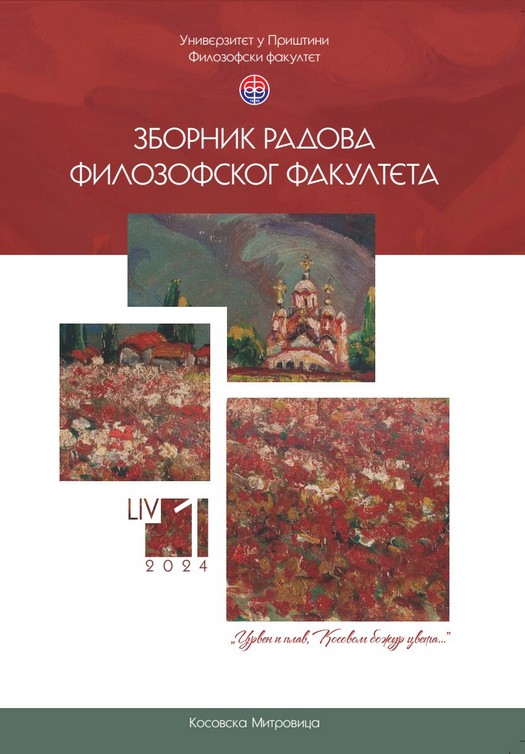Tourism as a Part of Sustainable Rural Development in the Area of Novi Pazar
Abstract
In insufficiently developed areas of Serbia, natural and anthropogenic tourist values are of great importance for sustainable rural development. In this study, a survey was conducted using the method of selecting respondents, where the analysis of economic, social, cultural, and environmental aspects took into consideration the current situation, with the goal of clearly defining all the strengths and weaknesses of rural settlements in Novi Pazar. The average values of related issues were used to calculate the value of the indicators, while the Sustainable Rural Development Index (SRDI) was determined by the average values of all indicators. The final outcome of the SRDI is 0.94, indicating that the area holds the potential to develop sustainable tourism. The results of the research can be used to plan the possibilities for further development of rural settlements in the researched area in order to minimize weaknesses and threats and maximize strengths and opportunities with the help of tourism based on sustainable development.
References
Становништво, упоредни преглед броја становника 1948, 1953, 1961, 1971, 1981, 1991, 2002, подаци по насељима. Републички завод за статистику, књ. 9. Београд, мај 2004.
Стратегија регионалног развоја Републике Србије за период од 2007. до 2012. године, Службени гласник РС, бр. 55/05 и 71/05.
Brackhahn, B., & Kärkkäinn, R. (2001). Spatial Planning as an Instrument for Promoting Sustainable Development in the Nordic Countries: Action Programme for 2001–2004. Copenhagen: Ministry of Environment and Energy.
Carmona, M. (2003). An international perspective on measuring quality in planning. Built Environment, 29(4), 281–287.
Clark, G., & Chabrel, M. (2007). Measuring integrated rural tourism. Tourism Geographies, 9(4), 371–386.
Collins-Kreiner, N., & Wall, G. (2007). Evaluating tourism potential: A SWOT analysis of the Western Negev, Israel. Tourism: International Interdisciplinary Journal, 55(1), 51–63.
Costanza, R., & Patten, BC. (1995). Defining and predicting sustainability. Ecological Economics, 15(3), 193–196.
Drakulić Kovačević, N., Kovačević, L., Stankov, U., Dragićević, V., & Miletić, A. (2018). Applying destination competitiveness model to strategic tourism development of small destinations: The case of South Banat district. Journal of Destination Marketing & Management, 8, 114–124.
Gorbenkova, E., Shcherbina, E., & Starolavnikova, O. (2015). Method for determining the agro-town’s development index. Scientific Open Access Journal Naukovedenie, 7(2), 97–109.
Hall, R., & Andriani, P. (2002). Managing knowledge for innovation. Long Range Planning, 35(1), 29–48.
Hashemi, N. (2010). The role of ecotourism in sustainable rural development. Journal of Rural Development Studies, 13(3), 173–188.
Hashemi, N., & Ghaffary, G. (2017). A proposed Sustainable Rural Development Index (SRDI): Lessons from Hajij village, Iran. Tourism Management, 59, 130–138.
Hill, T., & Westbrook, R. (1997). SWOT analysis: It’s time for a product recall. Long Range Planning, 30(1), 46–52.
Ho, M. W., & Ulanowicz, R. (2005). Sustainable systems as organisms?. Biosystems, 82(1), 39–51.
Jovanović, S. (2002). Razvoj poljoprivrede u Novopazarskom kraju. Zbornik radova Geografskog fakulteta, 50, 131–144.
Kim, H., & Jamal, T. (2007). Touristic quest for existential authenticity. Annuals of Tourism Research, 34(1), 181–201.
Kvrgić, G. i Ristić, L. (2018). Unutrašnji izazovi održivog razvoja ruralnih područja Republike Srbije. Naučne publikacije Državnog univerziteta u Novom Pazaru, 1(1), 28–46.
Mafunzwaini, A. E., & Hugo, L. (2005). Unlocking the rural tourism potential of the Limpopo province of South Africa: Some strategic guidelines. Development Southern Africa, 22(2), 251–265.
Mebratu, D. (1998). Sustainability and sustainable development: Historical and conceptual review. Environmental Impact Assessment Review, 18(6), 493–520.
NOAA (2011). Assessment for Sustainable Tourism. http://sanctuaries.noaa.gov/management/international/pdfs/day2_assessment_manual.pdf
Oppermann, M. (1996). Rural tourism in southern Germany. Annuals of Tourism Research, 23(1), 86–102.
Presenzaa, A., Petruzzellib, A. M., & Sheehan, L. (2019). Innovation through tradition in hospitality. The Italian case of Albergo Diffuso. Tourism Management, 72, 192–201.
Ristić, D., Vukoičić, D., & Milinčić, M. (2019). Tourism and sustainable development of rural settlements in protected areas – Example NP Kopaonik (Serbia). Land Use Policy, 89, 1–11.
Sharpley, R. (1994). Tourism, Tourist & Society. Huntington, Cambridgeshire: ELM.
Sorensen, J., & Stuart, T. E. (2000). Aging, obsolescence, and organizational innovation. Administrative Science Quarterly, 45, 81–112.
Srivastava, P. K., Kulshreshtha, K., Mohanty, C. S., Pushpangadan, P., & Singh, A. (2005). Stakeholder-based SWOT analysis for successful municipal solid waste management in Lucknow, India. Waste Management, 25(5), 531–537.
Wong, C., Baker, M., & Kidd, S. (2006). Monitoring spatial strategies: The case of local development documents in England. Environment and Planning C Government and Policy, 24(4), 533–552.
Yan, L., Wendy Gao, B., & Zhang, M. (2017). A mathematical model for tourism potential assessment. Tourism Management, 63, 355–365.
The details about the publication policy, including copyright and licensing, are available at:

